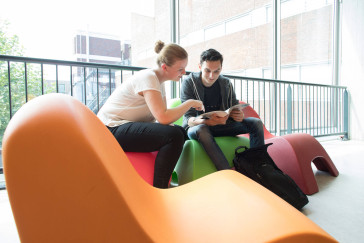Abstract: Embodied embedded cognition (EEC) has gained support in cognitive science as well as in human–computer interaction (HCI). EEC can be characterized both by its action-centeredness as well as its roots in phenomenology. The phenomenological aspects of EEC could be seen as support for trends in design emphasizing the user experience. Meanwhile, usability issues often are still approached using traditional methods based on cognitivist assumptions. In this paper, I argue for a renewed focus on improving usability from an EEC perspective. I draw mainly on a behavior-oriented interpretation of the theory, the key aspects of which are reviewed. A tentative sketch for an embodied embedded usability is proposed, doing justice to the embodied embedded nature of interaction while retaining the goal of developing technology that is easy to use in everyday practice.
LINK
This investigation explores relations between 1) a theory of human cognition, called Embodied Cognition, 2) the design of interactive systems and 3) the practice of ‘creative group meetings’ (of which the so-called ‘brainstorm’ is perhaps the best-known example). The investigation is one of Research-through-Design (Overbeeke et al., 2006). This means that, together with students and external stakeholders, I designed two interactive prototypes. Both systems contain a ‘mix’ of both physical and digital forms. Both are designed to be tools in creative meeting sessions, or brainstorms. The tools are meant to form a natural, element in the physical meeting space. The function of these devices is to support the formation of shared insight: that is, the tools should support the process by which participants together, during the activity, get a better grip on the design challenge that they are faced with. Over a series of iterations I reflected on the design process and outcome, and investigated how users interacted with the prototypes.
DOCUMENT

From the article: Abstract Over the last decades, philosophers and cognitive scientists have argued that the brain constitutes only one of several contributing factors to cognition, the other factors being the body and the world. This position we refer to as Embodied Embedded Cognition (EEC). The main purpose of this paper is to consider what EEC implies for the task interpretation of the control system. We argue that the traditional view of the control system as involved in planning and decision making based on beliefs about the world runs into the problem of computational intractability. EEC views the control system as relying heavily on the naturally evolved fit between organism and environment. A ‘lazy’ control structure could be ‘ignorantly successful’ in a ‘user friendly’ world, by facilitating the transitory creation of a flexible and integrated set of behavioral layers that are constitutive of ongoing behavior. We close by discussing the types of questions this could imply for empirical research in cognitive neuroscience and robotics.
LINK
Onderzocht wordt in hoeverre embodied cognition activiteiten bij meetkundeonderwijs in de bovenbouw van de basisschool leerlingen aanzetten tot wiskundig denken (abstraheren) en op welke manier leerkrachten dit proces kunnen begeleiden.

Onderzocht wordt in hoeverre embodied cognition activiteiten bij meetkundeonderwijs in de bovenbouw van de basisschool leerlingen aanzetten tot wiskundig denken (abstraheren) en op welke manier leerkrachten dit proces kunnen begeleiden. Looptijd 01 september 2019 - 31 augustus 2023
The PhD research by Joris Weijdom studies the impact of collective embodied design techniques in collaborative mixed-reality environments (CMRE) in art- and engineering design practice and education. He aims to stimulate invention and innovation from an early stage of the collective design process.Joris combines theory and practice from the performing arts, human-computer interaction, and engineering to develop CMRE configurations, strategies for its creative implementation, and an embodied immersive learning pedagogy for students and professionals.This lecture was given at the Transmedia Arts seminar of the Mahindra Humanities Center of Harvard University. In this lecture, Joris Weijdom discusses critical concepts, such as embodiment, presence, and immersion, that concern mixed-reality design in the performing arts. He introduces examples from his practice and interdisciplinary projects of other artists.About the researchMultiple research areas now support the idea that embodiment is an underpinning of cognition, suggesting new discovery and learning approaches through full-body engagement with the virtual environment. Furthermore, improvisation and immediate reflection on the experience itself, common creative strategies in artist training and practice, are central when inventing something new. In this research, a new embodied design method, entitled Performative prototyping, has been developed to enable interdisciplinary collective design processes in CMRE’s and offers a vocabulary of multiple perspectives to reflect on its outcomes.Studies also find that engineering education values creativity in design processes, but often disregards the potential of full-body improvisation in generating and refining ideas. Conversely, artists lack the technical know-how to utilize mixed-reality technologies in their design process. This know-how from multiple disciplines is thus combined and explored in this research, connecting concepts and discourse from human-computer interaction and media- and performance studies.This research is a collaboration of the University of Twente, Utrecht University, and HKU University of the Arts Utrecht. This research is partly financed by the Dutch Research Council (NWO).Mixed-reality experiences merge real and virtual environments in which physical and digital spaces, objects, and actors co-exist and interact in real-time. Collaborative Mix-Reality Environments, or CMRE's, enable creative design- and learning processes through full-body interaction with spatial manifestations of mediated ideas and concepts, as live-puppeteered or automated real-time computer-generated content. It employs large-scale projection mapping techniques, motion-capture, augmented- and virtual reality technologies, and networked real-time 3D environments in various inter-connected configurations.This keynote was given at the IETM Plenary meeting in Amsterdam for more than 500 theatre and performing arts professionals. It addresses the following questions in a roller coaster ride of thought-provoking ideas and examples from the world of technology, media, and theatre:What do current developments like Mixed Reality, Transmedia, and The Internet of Things mean for telling stories and creating theatrical experiences? How do we design performances on multiple "stages" and relate to our audiences when they become co-creators?Contactjoris.weijdom@hku.nl / LinkedIn profileThis research is part of the professorship Performative Processes